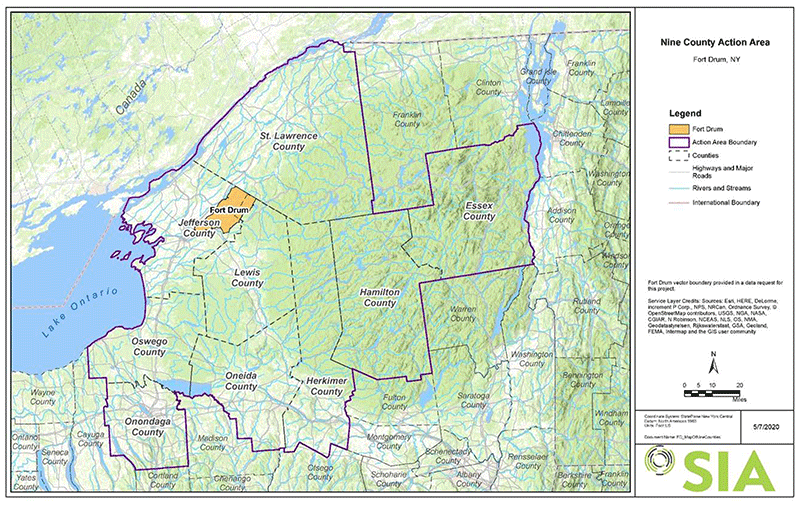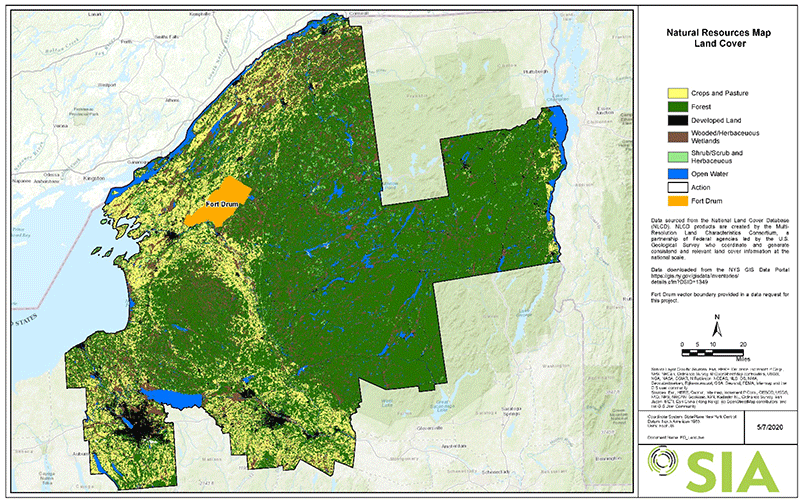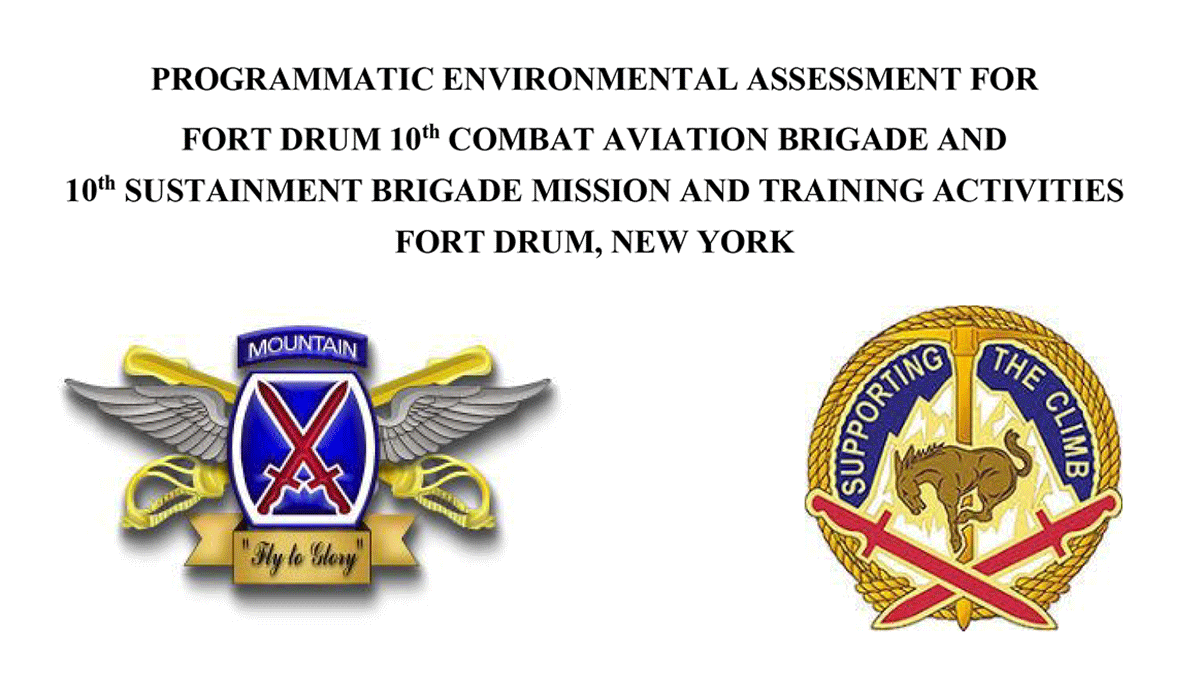The 10th Mountain Division at Fort Drum seeks wild areas in the Adirondack Park and the Forest Preserve for intensive air and land training activities
In June, the 10th Mountain Division of the U.S. Army, based at Fort Drum in Jefferson County, released a draft programmatic environmental assessment titled “Fort Drum 10th Mountain Combat Aviation Brigade and 10th Sustainment Brigade Mission and Training Activities” that outlines ambitious “air and land-based training activities” to possibly take place across nine counties in Upstate New York, including four (St. Lawrence, Lewis, Oneida, Herkimer) that are partially within the Adirondack Park, and two (Hamilton, Essex) that are entirely within the Adirondack Park Blue Line. (Henceforth the Programmatic Environmental Assessment will be referred to as the “PEA”). These training sessions would combine air and on-ground motor vehicle activities and run for 14 days, with a 7-day clean-up period to “return the property to its condition prior to the exercise,” hence totaling 21 days each. The PEA calls for as many as six training actions a year, for a total of 126 days.
The PEA looks at Forest Preserve sites to base their training camps that are cleared areas of 5 to 10 acres, which must “be free of trees.” Such cleared areas are not widespread in the Forest Preserve in the six counties listed in the PEA, or anywhere else for that matter outside of agricultural lands, mostly outside the Park. The impacts associated with these events would be significant and long-term.
The PEA states:
Temporary off-post locations would be used in support of training scenarios, training aids (i.e., training emitters during division exercises for aviation detection), and temporary sustainment sites (e.g., providing food, water, sleep area, shower, fuel, communications). Sustainment sites would include tent structures for sleeping, meetings, meals, and maintenance of equipment. Other areas within the sustainment sites would include generators, fuel containers, fuel dispensing trucks, food kitchen, storage containers, and parking areas for supply trucks. (p FNSI-ii)
The PEA details a wide breadth of activities, but fails to show an understanding of important New York State environmental laws, the Adirondack Park, the 2.6-million-acre public Adirondack Forest Preserve, and basic management of Forest Preserve lands classified as “Wilderness” areas. Protect the Adirondacks finds the activities outlined in the PEA are best suited for State Forest areas outside the Adirondack Park, which are logged, or on state conservation easement lands, which are abundant in the western Adirondacks near Fort Drum. These state lands have large cleared areas for log landings and sorting, an extensive road system used by a range of different motor vehicles, and forests that are logged. These areas would provide remote and wild settings, yet are far from residences and popular public recreation opportunities.
Click here to read the letter submitted by Protect the Adirondacks to the 10th Mountain Division.

This map details the nine county area where the 10th Mountain Division is seeking to stage combined air and ground training operations outside of the base in remote settings that would last 21 days each.
Conservation Easements Should be Used for Training Activities and Stakeholders Group Should be Convened
The PEA does not discuss use of State Conservation Easement lands for training activities. These are lands where the state has purchased the development rights, which are basically extinguished, and limited public recreation rights, while the commercial forest management rights are held by a private landowner. Conservation easement lands are intensively logged.
The air and ground training activities outlined in the PEA will have a major impact on wild places where they are staged in the North Country. These activities are best suited for managed forestlands, such as State Forests and State Conservation Easements, that have the road infrastructure and open clearings required. These areas are also remote from residential areas and possess extensive open space tracts of tens of thousands of acres. The large conservation easements north of Route 3 in St. Lawrence County may be suitable to the proposed activities detailed in the PEA. Use of conservation easement lands should be evaluated.
Major Issues in the 10th Mountain Division Training Program Proposal
There are major issues where the PEA fails to fully assess and evaluate the legal and ecological conditions of different lands within the Adirondack Park. Protect the Adirondacks has focused on the following three areas where the PEA failed to grapple with the legal issues involved.
Wilderness Areas: There are nearly 1.2 million acres of Wilderness in the Adirondack Park and five of the six counties referenced in the PEA as being partly or entirely with the Park have Wilderness holdings. While the PEA references “wilderness” as existing in Herkimer and St. Lawrence counties (p 25) it fails to state that Wilderness is major land area in Essex, Hamilton, and Lewis counties. A search of the PEA only found two references to Wilderness lands.
The fundamental purpose of a Wilderness area is that it is a protected landscape where ecological processes are allowed to proceed unimpacted by humans to the greatest extent possible. As a result, human impacts are minimized to those caused by walking, paddling, or cross-country skiing. A central tenet of Wilderness area management is the absence of motor vehicles or bicycles from a large landscape. Wilderness areas by their basic definition are supposed to receive the lightest of impacts from human recreational activities. Additionally, Wilderness areas have group size limits that are well below the sizes of the training activities outlined in the PEA. The Adirondack Park State Land Master Plan (APSLMP) articulates this purpose in its basic definition of Wilderness:
A wilderness area, in contrast with those areas where man and his own works dominate the landscape, is an area where the earth and its community of life are untrammeled by man–where man himself is a visitor who does not remain. A wilderness area is further defined to mean an area of state land or water having a primeval character, without significant improvement or permanent human habitation, which is protected and managed so as to preserve, enhance and restore, where necessary, its natural conditions, and which (1) generally appears to have been affected primarily by the forces of nature, with the imprint of man’s work substantially unnoticeable; (2) has outstanding opportunities for solitude or a primitive and unconfined type of recreation; (3) has at least ten thousand acres of contiguous land and water or is of sufficient size and character as to make practicable its preservation and use in an unimpaired condition; and (4) may also contain ecological, geological or other features of scientific, educational, scenic or historical value. (p 22)
The basic Wilderness definition states that lands classified as Wilderness should be managed in a wild, natural, untrammeled state where any impacts or marks of humans are difficult to detect. Protect the Adirondacks finds that the scope of activities in the PEA are incompatible with Wilderness lands in the Adirondack Park. The Wilderness guidelines in the APSLMP, partly quoted above, simply do not allow the proposed activities in the PEA in Wilderness Areas.
State Land Master Plan: The APSLMP classifies the Forest Preserve into a number of different land use types. The APSLMP places a premium on natural resource protection: “If there is a unifying theme to the master plan, it is that the protection and preservation of the natural resources of the state lands within the Park must be paramount. Human use and enjoyment of those lands should be permitted and encouraged, so long as the resources in their physical and biological context as well as their social or psychological aspects are not degraded.” (p 1)
In addition to Wilderness areas, the biggest Forest Preserve classification is “Wild Forest,” which generally allows a higher degree and more intensive forms of outdoor recreation. Wild Forest areas, for example, allow motor vehicle use on roads and snowmobile use on designated snowmobile trails. While motorized activities are authorized in Wild Forest areas, clearings of 5 to 10 acres do not exist. The PEA states that its proposed field training activities require clearings of 5 to 10 acres and these would not be possible even in Wild Forest areas where some kinds of motor vehicle use is allowed.
Article 14/Forever Wild: The Adirondack Forest Preserve is protected by the State Constitution. Constitutional protections were provided to the Forest Preserve in Article 14, Section 1 at the 1894 Constitutional Convention (then Article 7, Section 7) and have remained unchanged ever since. The Constitutional protections for the Forest Preserve sets these lands apart from other public lands.
In the PEA there is only one mention of the State Constitution and its use is inaccurate: “Hamilton County lies entirely within the Adirondack Park and is the least populated county in New York. Because Hamilton County is located in the Adirondack Park, any development in the county is limited by the NYS Constitution, which protects the park land. Most of the park land is publicly owned. Hamilton County offers forested mountains, 77 major lakes, and countless plunging streams. The county has nine towns and one incorporated village. Tourism is the most important industry and the whole area is a favorite spot for vacationers and recreationalists.” Development in Hamilton County on private lands is regulated jointly by the APA and local governments. The Forest Preserve, which is public land, is protected under the State Constitution and managed jointly by the APA and DEC. Here’s Article 14, Section 1, of the State Constitution:
The lands of the state, now owned or hereafter acquired, constituting the forest preserve as now fixed by law, shall be forever kept as wild forest lands. They shall not be leased, sold or exchanged, or be taken by any corporation, public or private, nor shall the timber thereon be sold, removed or destroyed.
Under the State Constitution, trees cannot be cut down or cleared to create a 5 to 10 acre clearing to facilitate the activities proposed by the 10th Mountain Division.

The Adirondack Park areas on this map of the nine counties proposed for training activities are heavily forested where appropriate sites with 5 to 10 acre clearings are not available.
Forest Preserve is Unsuitable for Proposed Training Activities
For a number of reasons the Forest Preserve is unsuitable for 126 days of intensive air and ground training activities annually. The PEA requires remote sites of 5 to 10 acres of open space in a forested setting with motor vehicle access, which are not available on the public Forest Preserve. The PEA states that the 5 to 10 acre training sites should be “Preferably grass, fields with few to no trees or shrubs.” There are very few such places, if any, in the Forest Preserve with “few to no trees.” Campers on the Forest Preserve must use only dead and downed wood for camp fires; no standing live or dead trees are allowed to be cut down. Campers are fined for cutting standing trees. There is also a significant body of case law that bars the “destruction” of trees on the Forest Preserve because the New York Constitution specifically protects Forest Preserve trees against destruction. Under the State Constitution, trees cannot be cut down or cleared to create a 5 to 10 acre clearings to facilitate the proposed training activities.
There are four other major areas where the proposed training activities are unsuitable for the Forest Preserve.
Proposed Training Activities are Incompatible with Public Outdoor Recreation in the Adirondacks: The PEA states “Because training is temporary, any impacts to land use would be short-term in nature. Schools, churches, and populated areas would be avoided. It is recommended if parks and recreation areas are used, they are avoided during peak times (hunting, fishing, and boating seasons). Coordination with owner would occur prior to the start of training exercises. Impacts to land use would be adverse, short-term and minor as no permanent changes to designated land uses would be made.” This is a broad category. The Forest Preserve units in the six counties referenced in the PEA (St. Lawrence, Lewis, Oneida, Herkimer, Hamilton, Essex) are used by the public for outdoor recreation nearly continuously. In an average calendar year in New York, the fishing season begins on April 1st, with later start dates for different species. Some fishing seasons close in the fall, others continue through March 15th because of the popularity of winter ice fishing. Hunting seasons start in late September and run through December. Trapping seasons start in the fall and many run through the winter into March.
Outdoor public recreation intensifies in the spring in May with active hiking, camping, and mountainbiking and runs deep into the fall. Winter hiking, snowshoeing, cross-country skiing, and camping are also popular and run through the winter into late March. Snowmobiling is popular and begins at the end of hunting season in December and runs through the winter into March. In short, there are few times of the year that the proposed activities detailed in the PEA will not have negative impacts on land use, mostly on the millions who use the Forest Preserve for a variety of outdoor recreational activities.
Negative Noise Impacts: The PEA provides an analysis on “Noise” that could be generated by combined air and land training activities and states “Training exercises are short-term. Helicopter overflights associated with the training exercises would be infrequent and of a short duration. Aviators are instructed to avoid flyovers of residential areas, known wildlife refuges, and livestock. For areas where aviators takeoff, land, and hover, and during engine run-ups, receivers of noise may experience additional disturbances. The number and amount of disturbances will also be dependent on the number of aircraft involved in the training exercises. Therefore, noise impacts on human annoyance and domestic animals would be adverse, short-term, and range from negligible to minor. Noise impacts on wildlife would be adverse, short-term, and range from negligible to moderate.” While there is considerable information on noise generated by different helicopters and motor vehicles, the literature cited by the PEA on wildlife impacts is two decades old and not specifically related the terrain and habitat of the Northeast U.S. Moreover, there is little about noise intrusions into public Wilderness areas where quiet, interrupted only by the sounds of wild nature, dominates and is one of the virtues of Wilderness. Due to the limited amount of information in the PEA, it’s impossible to assess noise impacts from the training activities proposed. Much more information is necessary.
Long-Term Negative Impacts: The PEA states “Training activities would result in adverse, short- and long-term, negligible to moderate impacts to biological resources. Impacts could include removal of vegetation from clearing, crushing, or trampling; spreading of invasive species from soil disturbances; and disturbances to wildlife, including threatened or endangered species, and habitats from noise and visual disturbances during training exercises. There could also be long-term impacts from habitat alteration, mortality of individual animals, or destruction of nests and eggs of ground-nesting birds. Implementing appropriate conservation measures and terms and conditions and following permit conditions would ensure that adverse impacts are avoided, minimized, or mitigated as necessary. Final conservation measures would be developed in consultation with USFWS and NYSDEC at the time of site selection.” Clearly, “removal of vegetation from clearing, crushing, or trampling” of trees is prohibited by the State Constitution. Furthermore, cutting of trees is long-term damage. The PEA fails to address long-term damage to a forest from clearing 5 to 10 acres blocks.
PEA Violates National Historic Register Protections for the Forest Preserve: Under the “Cultural Resources” section, the PEA states that “Known historic resources would be avoided. However, training exercises have the potential to impact unknown archaeological resources. BMPs [Best Management Practices] would be followed to ensure impacts to cultural resources remain minor. Impacts to cultural resources would be adverse, short- or long-term and minor to moderate.” The PEA fails to recognize that the Forest Preserve is listed on the National Register of Historic Places! Clearly, the PEA should recognize this important fact. The Forest Preserve in New York was listed on the National Register of Historic Places in 1966.
Recommendations to the 10th Mountain Division
The activities proposed in the PEA are best suited for managed forestlands, such as State Forests and State Conservation Easements, that have the road infrastructure and open clearings of 5 to 10 acres. These areas are also remote from residential areas and possess extensive open space tracts of tens of thousands of acres. The large conservation easements north of Route 3 in St. Lawrence County in the northwest Adirondacks may be suitable to the proposed activities detailed in the PEA. Use of conservation easement lands should be evaluated because the Forest Preserve is unsuitable.
Recent statements in the press and public correspondence announced that some form of stakeholder group may be formed to help the 10th Mountain Division assess the viability of different locations in the North Country for training air and ground training activities. Protect the Adirondacks would be pleased to help with such an effort. We note that both the New York and Vermont Air National Guards successfully managed these types of public outreach efforts, which helped to both meet the national defense needs and protect the Adirondack Park.
Protect the Adirondacks will continue to monitor this proposal.






